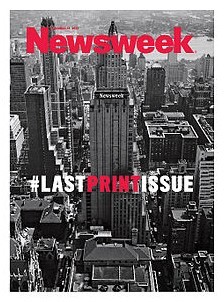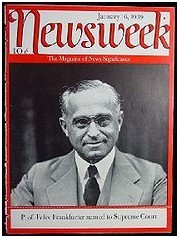
| Newsweek | |
 The cover of the December 31, 2012 issue of Newsweek, the last United States print issue of the magazine. |
|
| Editor | Tina Brown |
| Categories | News magazine |
| Frequency | Weekly |
| Publisher | NA |
|
Total circulation (2012) |
1,527,156[1] |
| First issue | February 17, 1933 |
| Final issue | December 31, 2012 (print) |
| Company | The Newsweek Daily Beast Company |
| Country | United States |
| Based in | New York, New York |
| Language | English |
| Website | www.newsweek.com |
| ISSN | 0028-9604 |
Newsweek was an American weekly news magazine that was published in New York City in print form from 1933 to 2012. Its print edition was distributed throughout the United States and internationally. It was the second-largest news weekly magazine in the U.S., having trailed Time in circulation and advertising revenue for most of its existence. It was published in four English language editions and 12 global editions written in the language of the circulation region. Newsweek continues as a news reporting and opinion website with its first digital-only issue published on January 4, 2013 and is still being printed in the UK and Europe.
Between 2008 and 2012, Newsweek underwent internal and external contractions designed to shift the magazine's focus and audience while improving its finances. Instead, losses accelerated: revenue dropped 38 percent from 2007 to 2009. The revenue declines prompted an August 2010 sale by owner The Washington Post Company to 92-year-old audio pioneer Sidney Harman—for a purchase price of $1.00 and an assumption of the magazine's liabilities.[2][3] Editor Jon Meacham left the magazine after the sale.[3]
In November 2010, Newsweek merged with the news and opinion website The Daily Beast, forming the Newsweek Daily Beast Company, after negotiations between the owners of the two publications. Tina Brown, The Daily Beast's editor-in-chief served as the editor of both publications. Newsweek was jointly owned by the estate of the late Harman and the diversified American Internet company IAC.
On October 18, 2012, Brown announced that Newsweek would cease print publication - at least in the U.S. - with the December 31, 2012, issue and transition to an all-digital format, to be called Newsweek Global.[6][7][8]
On April 29, 2013, IAC/Interactive Corporation Chairman and Founder Barry Diller stated at the Milken Global Conference that he "wished he hadn't bought" Newsweekbecause his company had lost money on the magazine and called the purchase a "mistake" and a "fool's errand."[9]
Circulation and branches
In 2003, worldwide circulation was more than 4 million, including 2.7 million in the U.S; by 2010 it was down to 1.5 million (with newsstand sales declining to just over 40 thousand copies per week). Newsweek publishes editions in Japanese, Korean, Polish, Spanish, Rioplatense Spanish, Arabic, and Turkish, as well as an English languageNewsweek International. Russian Newsweek, published since 2004, was shut in October 2010.[10]The Bulletin (an Australian weekly until 2008) incorporated an international news section from Newsweek.
Based in New York City, the magazine has 22 bureaus: nine in the U.S.: New York City, Los Angeles, Chicago/Detroit, Dallas, Miami, Washington, D.C., Boston and San Francisco, as well as overseas in London, Paris, Berlin, Moscow, Jerusalem, Baghdad, Tokyo, Hong Kong, Beijing, South Asia, Cape Town, Mexico City and Buenos Aires.
History


News-Week was launched in 1933 by Thomas J.C. Martyn, a former foreign-news editor for Time. He obtained financial backing from a group of U.S. stockholders "which included Ward Cheney, of the Cheney silk family, John Hay Whitney, and Paul Mellon, son of Andrew W. Mellon". Paul Mellon's ownership in Newsweek apparently represented "the first attempt of the Mellon family to function journalistically on a national scale."[11] The group of original owners invested around $2.5 million. Other large stockholders prior to 1946 were public utilities investment banker Stanley Childs, and Wall Street corporate lawyer Wilton Lloyd-Smith.
The first issue of the magazine was dated 17 February 1933. Seven photographs from the week's news were printed on the first issue's cover.[12]
In 1937 News-Week merged with the weekly journal Today, which had been founded in 1932 by future New York Governor and diplomat W. Averell Harriman, and Vincent Astor of the prominent Astor family. As a result of the deal, Harriman and Astor provided $600,000 in venture capital funds and Vincent Astor became both the chairman of the board and its principal stockholder between 1937 and his death in 1959.
In 1937 Malcolm Muir took over as president and editor-in-chief. He changed the name to Newsweek, emphasized interpretive stories, introduced signed columns, and launched international editions. Over time the magazine developed a broad spectrum of material, from breaking stories and analysis to reviews and commentary.
Under Post ownership
The magazine was purchased by The Washington Post Company in 1961.[13]
Richard M. Smith became Chairman in 1998, the year that the magazine inaugurated its "Best High Schools in America" list,[14] a ranking of public secondary schools based on the Challenge Index, which measures the ratio of Advanced Placement or International Baccalaureate exams taken by students to the number of graduating students that year, regardless of the scores earned by students or the difficulty in graduating. Schools with average SAT scores above 1300 or average ACT scores above 27 are excluded from the list; these are categorized instead as "Public Elite" High Schools. In 2008, there were 17 Public Elites.[15]
Smith resigned as board chairman in December 2007.[16]
Restructuring and new owner

The first issue released after the magazine switched to an opinion and commentary format.
During 2008–2009, Newsweek undertook a dramatic business restructuring. Citing difficulties in competing with online news sources to provide unique news in a weekly publication, the magazine refocused its content on opinion and commentary beginning with its May 24, 2009 issue. It shrank its subscriber rate base, from 3.1 million to 2.6 million in early 2008, to 1.9 million in July 2009 and then to 1.5 million in January 2010—a decline of 50% in one year. Meacham described his strategy as "counterintuitive" as it involved discouraging renewals and nearly doubling subscription prices as it sought a more affluent subscriber base for its advertisers.[19] During this period, the magazine also laid off staff. While advertising revenues were down almost 50% compared to the prior year, expenses were also diminished in a planned strategy that the publishers hoped would return Newsweek to profitability.
The financial results for 2009 as reported by The Washington Post Company showed that advertising revenue for Newsweek was down 37% in 2009 and the magazine division reported an operating loss for 2009 of $29.3 million compared to a loss of $16 million in 2008.[21] During the first quarter of 2010, the magazine lost nearly $11 million.
By May 2010, Newsweek had been losing money for the past two years and was put up for sale.[23] The sale attracted international bidders. One bidder was Syrian entrepreneur AbdulsalamHaykal, CEO of Syria-based publishing company Haykal Media, who brought together a coalition of Middle Eastern investors with his company. Haykal later claimed his bid was ignored by Newsweek's bankers, Allen & Co.[24]
The magazine was sold to audio pioneer Sidney Harman on August 2, 2010, for $1 in exchange for assuming the magazine's financial liabilities.[3][25] Harman's bid was accepted over three competitors.[26] Meacham left the magazine upon completion of the sale. Sidney Harman was the husband of Jane Harman, at that time a member of Congress from California.
On July 25, 2012, the company operating the Newsweek indicated the publication is likely to go digital to cover its losses and could undergo other changes by next year. Barry Diller, chairman and chief executive at the conglomerate IAC/InterActiveCorp, said his firm is looking at options now that its partner in the Newsweek/Daily Beast operation has pulled out.[27]
Merger with The Daily Beast
At the end of 2010, Newsweek merged with the online publication The Daily Beast, following extensive negotiations between the respective proprietors. Tina Brown, The Daily Beast's editor-in-chief, became editor of both publications. The new entity, The Newsweek Daily Beast Company, was 50% owned by IAC and 50% by Harman.
The goal of The Newsweek Daily Beast Company is to have The Daily Beast be a source of instant analysis of the news, while Newsweek would serve to take a look at the bigger picture, provide deeper analysis, and "connect the dots," in the words of Harman, and for both publications to ultimately be profitable.
During her tenure as editor-in-chief of Newsweek, Brown has taken the news weekly in a different direction than her predecessor. Whereas Jon Meacham looked to make the focus solely on politics and world affairs, Brown has brought the focus back on to all of current events, not just politics, business, and world affairs (although these issues are still the focus of the magazine). This is seen in increased attention fashion and pop culture and many of her covers since taking the job.
2011 redesign
Newsweek was redesigned in March 2011.[29] The new Newsweek moved the "Perspectives" section to the front of the magazine, where it served essentially as a highlight reel of the past week on The Daily Beast. More room was made available in the front of the magazine for columnists, editors, and special guests. A new "News Gallery" section featured two-page spreads of photographs from the week with a brief article accompanying each one. The "NewsBeast" section featured short articles, a brief interview with a newsmaker, and several graphs and charts for quick reading in the style of The Daily Beast. This is where the Newsweek staple "Conventional Wisdom" was located. Brown retained Newsweek's focus on in-depth, analytical features and original reporting on politics and world affairs, as well as a new focus on longer fashion and pop culture features. A larger culture section named "Omnivore" featured art, music, books, film, theater, food, travel, and television, including a weekly "Books" and "Want" section.
The back page was reserved for a "My Favorite Mistake" column written by celebrity guest columnists about a mistake they made that defines who they are.
Cessation of print format (U.S.)
On October 18, 2012 the company announced that the print edition would be discontinued at the end of 2012 after 80 years of publication.[6] The online edition is named "Newsweek Global".[8] The magazine is still available in hardcopy in the U.K. and Europe.
Highlights and controversies
Lewinsky scandal
Newsweek reporter Michael Isikoff was the first reporter to investigate allegations of a sexual relationship between U.S. President Bill Clinton and Monica Lewinsky, but the editors spiked the story.[31] The story soon surfaced online in the Drudge Report.
Claims of bias
A 2004 study by Tim Groseclose and Jeff Milyo asserted that Newsweek, along with all other mainstream news outlets except for Fox News and the Washington Times, exhibited a "liberal bias". While liberal media watchdogs like Media Matters for America and the Center for American Progress described the study as "riddled with flaws,"their opposite numbers had similarly commented on Newsweek's alleged liberal bias.
Newsweek's Washington Bureau Chief and later Assistant Managing Editor Evan Thomas variously acknowledged the charge saying, "I think Newsweek is a little liberal," and, in 1996, "there is a liberal bias at Newsweek, the magazine I work for."
Starting in 1976, conservative columnist George F. Will became a contributing editor, writing a biweekly backpage column.
Guantánamo Bay allegations
In the May 9, 2005 issue of Newsweek, an article by reporter Michael Isikoff stated that interrogators at Guantanamo Bay "in an attempt to rattle suspects, flushed a Qur'an down a toilet." Detainees had earlier made similar complaints but this was the first time a government source had appeared to confirm the story. The news was reported to be a cause of widespread rioting and massive anti-American protests throughout some parts of the Islamic world (causing at least 15 deaths in Afghanistan[41]). The magazine later revealed that the anonymous source behind the allegation could not confirm that the book-flushing was actually under investigation, and retracted the story under heavy criticism.
Iraq war planning
FareedZakaria, a Newsweek columnist and editor of Newsweek International, attended a secret meeting on November 29, 2001, with a dozen policy makers, Middle East experts and members of influential policy research organizations that produced a report for President George W. Bush and his cabinet outlining a strategy for dealing with Afghanistan and the Middle East in the aftermath of September 11, 2001. The meeting was held at the request of Paul D.
Wolfowitz, then the deputy secretary of defense. The unusual presence of journalists, who also included Robert D. Kaplan of The Atlantic Monthly, at such a strategy meeting was revealed in Bob Woodward's 2006 book State of Denial: Bush at War, Part III. Woodward reported in his book that, according to Mr. Kaplan, everyone at the meeting signed confidentiality agreements not to discuss what happened. Mr. Zakaria told The New York Times that he attended the meeting for several hours but did not recall being told that a report for the President would be produced.[42] On October 21, 2006, after verification, the Times published a correction that stated:
An article in Business Day on Oct. 9 about journalists who attended a secret meeting in November 2001 called by Paul D. Wolfowitz, then the deputy secretary of defense, referred incorrectly to the participation of FareedZakaria, the editor of Newsweek International and a Newsweek columnist. Mr. Zakaria was not told that the meeting would produce a report for the Bush administration, nor did his name appear on the report.[42]
2008 elections
In the 2008 U.S. presidential election, the John McCain campaign wrote a lengthy letter to the editor criticizing a cover story in May 2008.
Allegations of gender bias

Controversial Newsweek cover, November 23, 2009, issue
Former Alaska Governor and 2008 Republican Vice Presidential nominee Sarah Palin was featured on the cover of the November 23, 2009 issue of Newsweek, with the caption "How do you Solve a Problem Like Sarah?" featuring an image of Palin in athletic attire and posing. Palin herself, the Los Angeles Times and other commentators accused Newsweek of sexism for their choice of cover in the November 23, 2009 issue discussing Palin's book, Going Rogue: An American Life. "It's sexist as hell," wrote Lisa Richardson for the Los Angeles Times.[44]Taylor Marsh of The Huffington Post called it "the worst case of pictorial sexism aimed at political character assassination ever done by a traditional media outlet."[45] David Brody of CBN News stated: "This cover should be insulting to women politicians."[46]
The cover includes a photo of Palin used in the August 2009 issue of Runner's World. The photographer may have breached his contract with Runner's World when he permitted its use in Newsweek, as Runner's World maintained certain rights to the photo until August 2010. It is uncertain, however, whether this particular use of the photo was prohibited.[50]
Minnesota Republican Congresswoman and presidential candidate Michele Bachmann was featured on the cover of Newsweek magazine in August 2011, dubbed "the Queen of Rage".[51] The photo of her was perceived as unflattering, as it portrayed her with a wide eyed expression some said made her look "crazy".[52] Sources called the depiction "sexist",[53] and Sarah Palin denounced the publication. Newsweek defended the cover's depiction of her, saying its other photos of Bachmann showed similar intensity.[54]



















